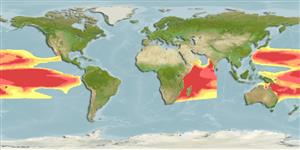Classification / Names
Common names | Synonyms | Catalog of Fishes(genus, species) | ITIS | CoL | WoRMS | Cloffa
Teleostei (teleosts) >
Stomiiformes (Lightfishes and dragonfishes) >
Stomiidae (Barbeled dragonfishes) > Melanostomiinae
Etymology: Photonectes: Greek, photos = light + Greek, nekton = swimmer (Ref. 45335); waitti: Named for Theodore (Ted) Waitt, the founder of the Waitt Family Foundation and the Waitt Institute.
Eponymy: Dr Theodore W ‘Ted’ Waitt (d: 1963) is an American philanthropist and businessman who attended the University of Iowa (1982–1984) but did not graduate -his doctorate is honorary and awarded by the University of South Dakota. [...] (Ref. 128868), visit book page.
Environment: milieu / climate zone / depth range / distribution range
Ecology
Marine; pelagic-oceanic; depth range 0 - 1200 m (Ref. 92891). Deep-water
Indo-Pacific: tropical, Gulf of Aden to the Coral Sea and the Hawaiian Islands.
Size / Weight / Age
Maturity: Lm ? range ? - ? cm
Max length : 7.4 cm SL male/unsexed; (Ref. 92891)
Short description
Identification keys | Morphology | Morphometrics
Dorsal soft rays (total): 11 - 14; Anal soft rays: 12 - 16. This species is distinguished from other species in the subgenus Photonectes by the following set of characters: dorsal-fin rays 11-14, anal-fin rays 12-16; IV photophores 38-39, PV photophores 24-25; no blue luminous tissue; reduced length of gill filaments on first branchial arch, less than depth of gill arch; barbel with 2 large bulbs in series; two large bulbs in series and a tiny bulb at the end of the filament. Photonectes waitti differs from P. mirabilis and P. phyllopogon in having 11-14 dorsal-fin rays (vs. 16-17 and 20-23, respectively), 12-16 anal-fin rays (vs. 19-20 and 22-25, respectively), and 38-39 IV photophores (vs. 33-34 and 30-31, respectively); from P. coffea in having gill filaments on first gill arch reduced (vs. very long, extending beyond gill opening), PV photophores 24-25 (vs. 29-31); from P. achirus, P. caerulescens, and P. mirabilis in lacking blue luminous tissue (Ref. 92891).
Life cycle and mating behavior
Maturity | Reproduction | Spawning | Eggs | Fecundity | Larvae
Flynn, A.J. and C. Klepadlo, 2012. Two new species of Photonectes (Teleostei: Stomiidae) from the Indo-Pacific, and a re-examination of P. achirus. Memoirs of Museum Victoria 69: 259-267. (Ref. 92891)
IUCN Red List Status (Ref. 130435: Version 2024-2)
Threat to humans
Harmless
Human uses
Tools
Special reports
Download XML
Internet sources
Estimates based on models
Preferred temperature (Ref.
123201): 9 - 19.8, mean 13 °C (based on 233 cells).
Phylogenetic diversity index (Ref.
82804): PD
50 = 0.5000 [Uniqueness, from 0.5 = low to 2.0 = high].
Bayesian length-weight: a=0.00302 (0.00116 - 0.00786), b=3.12 (2.89 - 3.35), in cm total length, based on LWR estimates for this (Sub)family-body shape (Ref.
93245).
Trophic level (Ref.
69278): 3.6 ±0.6 se; based on size and trophs of closest relatives
Resilience (Ref.
120179): High, minimum population doubling time less than 15 months (Preliminary K or Fecundity.).
Fishing Vulnerability (Ref.
59153): Low vulnerability (10 of 100).
